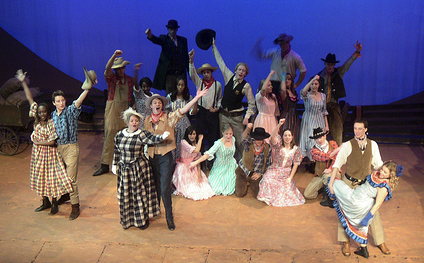
Three years ago I published a post titled The Farmer and the Cowman in which I acknowledged an epiphany about the relationship between arts marketing and community engagement. In the past six months I have, on several occasions, been re-confronted with the truth of their close relationship (when both are being done well). This was really driven home to me in the highly flattering (and most embarrassing) post written by Trevor O’Donnell Taking a Cheap Shot at Community Engagement.
In April I met with Amelia Northrup-Simpson of TRG Arts and we began hatching a plot. Beginning with some cross-posting on our blogs we would explore the relationships between our respective areas of expertise. This post is my introduction to that effort.
What has happened since April is that I’ve begun to be intrigued by the depth of the inter-relationships. In addition, I’m developing a fuller appreciation of the fact that fundraising is just another side of the same coin. (We now appear to be talking about a three-sided coin.) As a result, I’m coming to suspect that there may be a book lurking behind all of this addressing something like a “unified field theory” of arts management. Be warned.
The Original Post
As I grow up (an incredibly slow and painful process, especially at age 60), I find myself, in spite of myself, learning things. One of the most revealing lessons I’ve more fully grasped in the last year is that arts marketers and community engagement advocates can and should be the best of friends.
On first consideration, this is far from obvious. The two have vastly different ultimate goals, vastly divergent frames of reference. Marketers have as their core responsibility one pillar of the sustainability of the organization for which they work, sometimes translated as “butts in seats/eyes on walls.” Community advocates are focused on the community and its well-being. Because their work is in corporate settings (usually not-for-profit corporations, but corporations nonetheless), arts marketers have a corporate frame of reference. Community advocates, often working outside of the establishment, sometimes have a distrust of corporations. The two “camps” are ripe for an It’s a Wonderful Life dichotomy, not quite 99% vs. 1%, but in the ballpark.
I have come to be excited about the possibility of the two working together. Several things, in addition to the goals/frames of reference issues I just highlighted have gotten in the way of this in the past. Since results and targets are what is communicated outside of marketing meetings, marketing often looks like sales. I do know (and have always known) that the two have never been equated by marketers worth their salt, but it’s an easy trap into which to fall. Also, and this is significant in understanding misunderstandings, sales agents have thought and sometimes still do think of themselves as (and call themselves) marketers. This is not the fault of people who are marketers, but it gets in the way of grasping the differences between sales and marketing.
I also believe that over the last decade or two, arts marketing has changed. As the world has changed, arts marketers have come to understand more fully that relationship building (as a two-way enterprise) is a basic building block of their work. I don’t want to touch off a fire-storm by saying it’s a change, but if it’s not a change, I can say I never read much about this until relatively recently. Waiting in the Wings and Subscribe Now! dealt with relationships, but it was the one-way kind of relationship about which I’ve written before (One Way) rather than relationships rooted in reciprocal learning.
What is exciting to me is the potential for change that this represents. Marketers know the need for relationships outside the organization; they have a vested interest in relationship building. As insiders, they represent a mechanism for community-focused transformation in the arts establishment. Community advocates, as experts in relationship building outside corporate walls, represent a valuable resource for marketers. While there are differences in language and some history that might make trust initially difficult, let’s get these two groups together and enhance the vibrancy of the arts and of communities.
And here is the thing that has most changed in my thinking since writing this piece originally. I am now unwilling to put a bright line between marketing and sales. I have come to think of sales as an (or the) unavoidable metric for judging the success of marketing, so long as a time frame appropriate to the marketing goals is used. But that is a topic for another post.
Engage!
Doug
Photo:![]() Some rights reserved by Mark Cartwright
Some rights reserved by Mark Cartwright

Very excited about these posts about the inter-relationships between marketing and sales, fundraising, and community engagement… but I’d like to suggest a four-sided coin that includes artistic.
I serve as the Associate Artistic Director at The Pasadena Playhouse. As we strive for artistic excellence, we recognize that community-informed dramaturgy, removing the barriers between artists and community, and packed houses filled with robustly diverse audiences are all critical to achieving artistic excellence.
We use an artistic methodology called Consensus Organizing for Theatre (CO). It’s a type of community organizing where a theatre builds stake in multiple pockets of communities and those communities build stake back in the theatre by surfacing and organizing around mutual self-interests. It’s an artistic-led community organizing process which begins months before the actual production, and which results in ticket sales, new donors, new subscribers, new board members, deep relationships with the community… and great art.
My belief, as an artist is that art needs community, just as community needs art. Just as Doug Borwick is unwilling to put a bright line between marketing and sales and community engagement and fundraising, let’s not put a line between the art and these administrative functions.
I look forward to reading more of these posts!